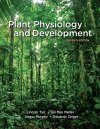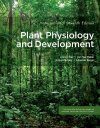About this book
Plant Physiology and Development incorporates the latest advances in plant biology, making Plant Physiology the most authoritative and widely used upper-division plant biology textbook. Up to date, comprehensive, and meticulously illustrated, the improved integration of developmental material throughout the text ensures that Plant Physiology and Development provides the best educational foundation possible for the next generation of plant biologists.
New to this Edition:
- New Introductory Unit 1, Structure and Information Systems of Plant Cells, containing four chapters that have been revised to serve as an introductory unit that can be used to ensure all students begin with a common starting point. The reorganization of Unit 1 also enables modernization of the teaching of traditional physiological topics by introducing genomics, molecular genetics, genome editing, and the basic concepts of signal transduction at the outset of the course. Unit 1 is also organized in a manner that allows the chapters to be used as reference material as students engage with the topics of subsequent chapters.
- Inclusion of highlight boxes that address climate change and biotechnology topics that are relevant to plant physiology.
- Chapter 15: Abiotic Stress has been brought forward to serve as a tool to assist students in integration of the concepts learned in the first three units of the text.
- The subject of Vegetative Growth and Organogenesis is now addressed in two chapters. Chapter 18: Vegetative Growth on the Primary Axis focuses on meristems and primary root, shoot and leaf development. Chapter 19: Vegetative Growth and Organogenesis: Branching and Secondary Growth includes updated sections describing the development of root architecture, cambial function, and epicormic branching.
- Chapter 24: Biotic Interactions has been reformulated to better integrate the concepts of Development with the first three units of the text. New material on plant responses to herbivory and pathogens has been extensively incorporated into the chapter.
- In addition to Topical Boxes, web-based Web Topics and Essays have been extensively updated to reflect new developments and to highlight plant breeding/biotechnology and the impacts of climate change. The Web material amplifies the theme of integrative approaches to solve global problems in food production, renewable energy, and environmental sustainability.
- Improves on efforts to include the most recent and important developments in plant science at a level of complexity that is appropriate for third- and fourth-year undergraduate plant physiology classes.
- Advanced genomics, molecular-assisted breeding, and plant genome engineering with CRISPR and similar tools are presented by leaders in the field.
- Conservative nomenclature for genes, gene products, mutants, and epigenetic factors has been standardized throughout the text.
- Concise suggested readings are included at the end of each textbook chapter and links to a more extensive online bibliography. Web Topics and Web Essays include associated references.
- New chapter authors, who are leaders in their respective field, bring an enhanced sense of relevance to the material presented.
Contents
I. Structure and Information Systems of Plant Cells
1. Plant and Cell Architecture
2. Cell Walls: Structure, Formation, and Expansion
3. Genome Structure and Gene Expression
4. Signals and Signal Transduction
II. Transport and Translocation of Water and Solutes
5. Water and Plant Cells
6. Water Balance of Plants
7. Mineral Nutrition
8. Solute Transport
III. Biochemistry and Metabolism
9. Photosynthesis: The Light Reactions
10. Photosynthesis: The Carbon Reactions
11. Photosynthesis: Physiological and Ecological Considerations
12. Translocation in the Phloem
13. Respiration and Lipid Metabolism
14. Assimilation of Inorganic Nutrients
15. Abiotic Stress
IV. Growth and Development
16. Signals from Sunlight
17. Germination and Establishment
18. Vegetative Growth on the Primary Axis
19. Secondary Vegetative Growth
20. Control of Flowering and Floral Development
21. Gametophyte Development, Pollination, and Fruit Development
22. Embryogenesis: The Origin of Plant Architecture
23. Plant Senescence and Cell Death
24. Biotic Interactions
Customer Reviews
Biography
Lincoln Taiz is Professor Emeritus of Molecular, Cellular, and Developmental Biology at the University of California at Santa Cruz. He received his PhD in Botany from the University of California at Berkeley. Dr Taiz's main research focus has been on the structure, function, and evolution of vacuolar H+-ATPases. He has also worked on gibberellins, cell wall mechanical properties, metal transport, auxin transport, and stomata opening.
Ian Max Møller is an Associate Professor at the Department of Molecular Biology and Genetics at Aarhus University, Denmark. He received his PhD in Plant Biochemistry from Imperial College, London, UK. He has worked at Lund University, Sweden and, more recently, at Riso National Laboratory and the Royal Veterinary and Agricultural University in Copenhagen, Denmark. Professor Moller has investigated plant respiration throughout his career. His current interests include the turnover of reactive oxygen species and the role of protein oxidation in plant cells.
Angus Murphy is a Professor and Chair of the Department of Plant Science and Landscape Architecture at the University of Maryland. He earned his PhD in Biology from the University of California, Santa Cruz in 1996. Dr Murphy studies ATP-binding cassette transporters, auxin transport proteins, and the role of auxin transport in programmed and plastic growth.
Eduardo Zieger is a Professor Emeritus of Biology at the University of California at Los Angeles. He received a PhD in Plant Genetics at the University of California at Davis. His research interests include stomatal function, the sensory transduction of blue-light responses, and the study of stomatal acclimations associated with increases in crop yields.
Contributors:
Andreas Blennow, University of Copenhagen
Eduardo Blumwald, University of California Davis
Federica Brandizzi, Michigan State University
Siobhan Braybook, University of California Los Angeles
John Browse, Washington State University
John Christie, University of Glasgow
Asaph B. Cousins, Washington State University
Susan Dunford, University of Cincinnati
José Feijo, University of Maryland
Simon Gilroy, University of Wisconsin Madison
N. Michele Holbrook, Harvard University
Roger Innes, Indiana University Bloomington
Alexander Jones, University of Cambridge
David M. Kramer, Michigan State University
June M. Kwak, Daegu Gyeongbuk Institute of Science and Technology
Pyung Ok Lim, Daegu Gyeongbuk Institute of Science and Technology
Zhongchi Liu, University of Maryland
Andreas Madlung, University of Puget Sound
Ronald Mittler, University of North Texas
Ian Max Møller, Aarhus University
Angus Murphy, University of Maryland
Sofia Otero, University of Cambridge
Wendy Peer, University of Maryland
Yiping Qi, University of Maryland
Simona Radutoiu, Aarhus University
Allan G. Rasmusson, Lund University
Nidhi Rawat, University of Maryland
Sarah Robinson, University of Cambridge
Darren Sandquist, California State University Fullerton
Alexander Schulz, University of Copenhagen
Claus Schwechheimer, Technische Universität München, Munich
Sarah Smith, Yale University
Young Hun Song, Seoul National University
Vijay Tiwari, University of Maryland
Yi-Fang Tsay, Academia Sinica
Michael Udvardi, The University of Queensland
John M. Ward, University of Minnesota
Christopher Whitewoods, University of Cambridge
Dolf Wiejers, Wageningen University of Research
Hye Run Woo, Daegu Gyeongbuk Institute of Science and Technology



































